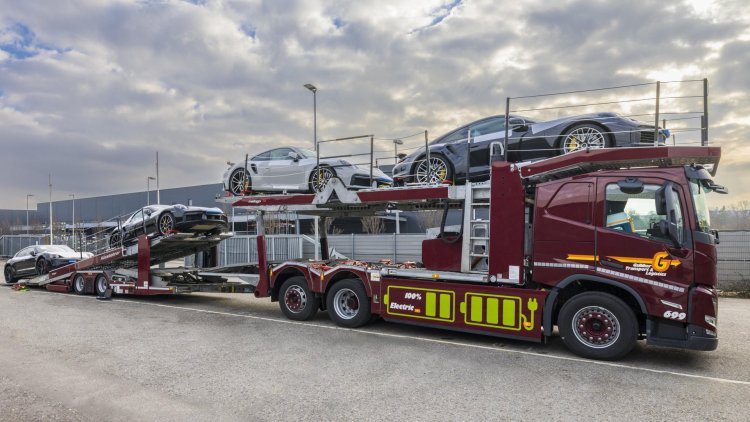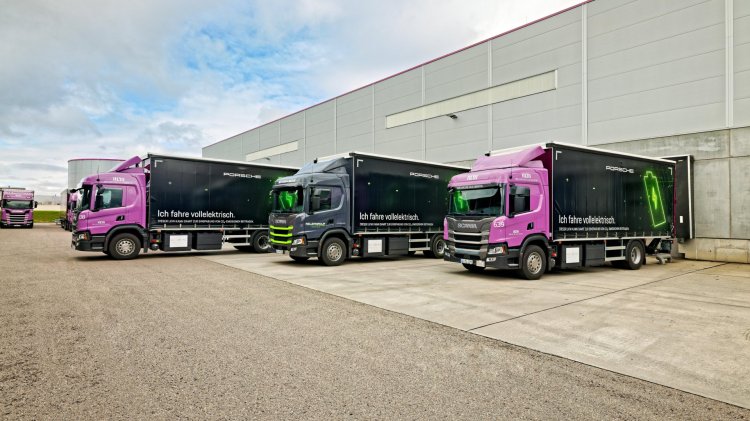Porsche is pushing forward with the roll-out of different drives in its transport logistics fleet: Along with its logistics companions, the sports activities automotive producer is utilizing six new electrical HGVs (heavy good car) at its Zuffenhausen, Weissach and Leipzig websites.
These autos transport manufacturing supplies across the vegetation, working alongside an current fleet of twenty-two biogas-fuelled HGVs. One other electrical HGV delivers new autos to Switzerland from the Zuffenhausen plant. As well as, the corporate is testing using artificial fuels (HVO100) in a multi-year trial below the scientific supervision of the Karlsruhe Institute of Know-how (KIT). For this goal, twelve HGVs from the prevailing fleet might be used across the Zuffenhausen plant – however now they are going to be powered by re-fuels.
In the midst of the decarbonisation of the corporate’s HGV transport logistics, HGVs powered by biogas (CNG and LNG) have been used, amongst others, at Porsche for a very long time. These will now be supplemented by the brand new electrical HGVs in the usual processes. Logistics companions Keller Group, Müller – Die lila Logistik and Elflein have additionally dedicated to working the electrical HGVs utilizing inexperienced electrical energy. This additionally applies to the brand new electrical HGV utilized by the logistics firm Galliker to ship new autos to the Swiss market from the Porsche manufacturing unit in Zuffenhausen.

Use of re-fuels with chosen vans within the current HGV fleet
Along with the enlargement of the electrical HGV fleet, Porsche has additionally been trialling using artificial diesel fuels (HVO100) in its current HGV fleet since 2020. The four-year pilot scheme is being performed in cooperation with the Karlsruhe Institute of Know-how (KIT) and Müller – Die lila Logistik. The logistics firm is utilising twelve HGVs as a part of the mission. NESTE’s HVO100 gas consists of residual and waste supplies and meets the present necessities of the Renewable Vitality Directive II (RED II).
In sensible use, the gas has to this point confirmed to be very spectacular. No disadvantages have been recognized in comparison with typical diesel gas – neither when it comes to gas consumption nor relating to engine reliability. To this point, a couple of million kilometres have been pushed as a part of the mission – in line with licensed measurements by KIT, this has saved greater than 800 tons of CO2. The lorries function a shuttle service within the better Stuttgart space. To make sure that significant outcomes may very well be drawn when evaluating the information, the take a look at vans – that are series-production autos with none modifications – have been utilized in parallel with diesel-powered HGVs on equivalent routes.

By rail and street – Porsche transport logistics
Examples together with using biogas and electrical HGVs or the pilot scheme involving re-fuels show how Porsche is dedicatedly managing its transport logistics to attain its set decarbonisation objectives. This contains rail transport. This mode is utilized in explicit for supplying elements and parts to vegetation or for transporting new autos to the seaports, the place the autos are then ready for export to locations outdoors Europe. Automobile manufacturing itself additionally contributes to the decarbonisation goal: Since 2020, car manufacturing on the Porsche websites in Zuffenhausen and Leipzig has had a CO2-neutral stability sheet throughout your entire worth chain and makes use of electrical energy generated through regenerative power sources.
